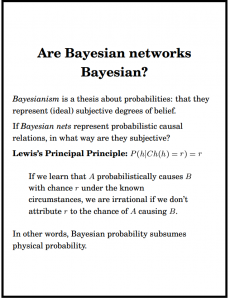In Bayesian Artificial Intelligence, authors Kevin B. Korb and Ann E. Nicholson points out the non-Bayesian nature of Belief networks. The researchers note
Many AI researchers like to point out that Bayesian networks are not inherently Bayesian at all; some have even claimed that the label is a misnomer. At the 2002 Australasian Data Mining Workshop, for example, Geoff Webb made the former claim. Under questioning it turned out he had two points in mind:
(1) Bayesian networks are frequently “data mined” (i.e., learned by some computer program) via non-Bayesian methods.(2) Bayesian networks at bottom represent probabilities; but probabilities can be interpreted in any number of ways, including as some form of frequency; hence, the networks are not intrinsically either Bayesian or non-Bayesian, they simply represent values needing further interpretation.
These two points are entirely correct. We shall ourselves present non-Bayesian methods for automating the learning of Bayesian networks from statistical data. We shall also present Bayesian methods for the same, together with some evidence of their superiority. The interpretation of the probabilities represented by Bayesian networks is open so long as the philosophy of probability is considered an open question.
Indeed, much of the work presented here ultimately depends upon the probabilities being understood as physical probabilities, and in particular as propensities or probabilities determined by propensities.
Nevertheless, we happily invoke the Principal Principle: where we are convinced that the probabilities at issue reflect the true propensities in a physical system we are certainly going to use them in assessing our own degrees of belief.
The advantages of the Bayesian network representations are largely in simplifying conditionalization, planning decisions under uncertainty and explaining the outcome of stochastic processes. These purposes all come within the purview of a clearly Bayesian interpretation of what the probabilities mean, and so, we claim, the Bayesian network technology which we here introduce is aptly named: it provides the technical foundation for a truly Bayesian artificial intelligence.
References
A Brief Introduction to Graphical Models and Bayesian Networks

